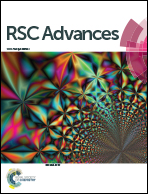Investigation of temperature and frequency dependence of the dielectric properties of multiferroic (La0.8Ca0.2)0.4Bi0.6FeO3 nanoparticles for energy storage application
Abstract
In this work we synthesized the multifunctional (La0.8Ca0.2)0.4Bi0.6FeO3 material using a sol–gel process. Structural and morphologic investigations reveal a Pnma perovskite structure at room temperature with spherical and polygonal nanoparticles. A detailed study of the temperature dependence of the dielectric and electrical properties of the studied material proves a typical FE–PE transition with a colossal value of real permittivity at 350 K that allows the use of this material in energy storage devices. Thus, the investigation of the frequency dependence of the ac conductivity proves a correlated barrier hopping (CBH) conduction mechanism to be dominant in the temperature ranges of 150–170 K; the two observed Jonscher's power law exponents, s1 and s2 between 180 K and 270 K correspond to the observed dispersions in the ac conductivity spectra in this temperature region, unlike in the temperature range of 250–320 K, the small polaron tunnel (NSPT) was considered the appropriate conduction model.



 Please wait while we load your content...
Please wait while we load your content...